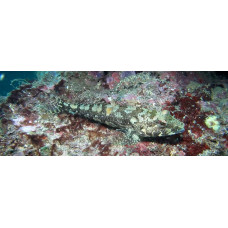Cottidae is a family of fishes of the order Scorpaeniformes. The body is naked or covered with spines and plates. The head is large, flattened with bony outgrowths and barbed spines. Marine, coastal and freshwater fish temperate and cold waters of the Pacific Ocean and North Atlantic. Over 70 genera, about 200 species. Length from 12 to 60 cm. Not of serious commercial importance. Freshwater pelagic and bottom fish. Feed on pelagic crustaceans, bottom invertebrates and fish fry. Cottocomephorus grewingkii plays a major role in the diet of omul, grayling and seal. Cottus gobio is listed as a rare fish in Europe.
Total body length ranges from about 5 cm in some small species to 1 m in Scorpaenichthys marmoratus. The body often appears naked, usually covered with scales, various bony plates or spines hidden in the skin, but never completely covered with plates forming a carapace. The head is usually broad, flattened, armed with barbed spines, often having the form of horns. All representatives of the family are characterized by two well-defined dorsal fins (separated or contiguous), of which the first is always smaller than the second. Caudal fin is well separated from the second dorsal and anal fin, usually truncated or rounded, its rays branched. Pectoral fins are large. The pelvic fin is located below the pectoral fins, in one species is absent. It has one barb and 2-5 (usually 2 or 3) soft rays, the first unbranched ray is always connected to the first articulate ray, forming as if one ray. Anal fin without barbed rays, in length equal to the second dorsal fin. Swim bladder in adult fish is absent. Eyes are usually large, located high on the head. Lateral line is single. Teeth are weak numerous bristle-shaped. Males of some species have a copulatory organ - urogenital papilla.
The family range covers the northern hemisphere, eastern Australia, coastal waters of New Guinea and New Zealand. The greatest diversity of species in the coastal waters of the North Pacific Ocean, less in the Arctic and North Atlantic; representatives of five genera are distributed in fresh water bodies of Eurasia and North America; in the southern hemisphere there are only 4 deep-water species of the genus Antipodocottus, inhabiting waters near Australia, Kai Islands west of New Guinea and New Zealand. Most species of the family are marine, living near the coasts, near the bottom.
Cottidae
Tags: cottidae



